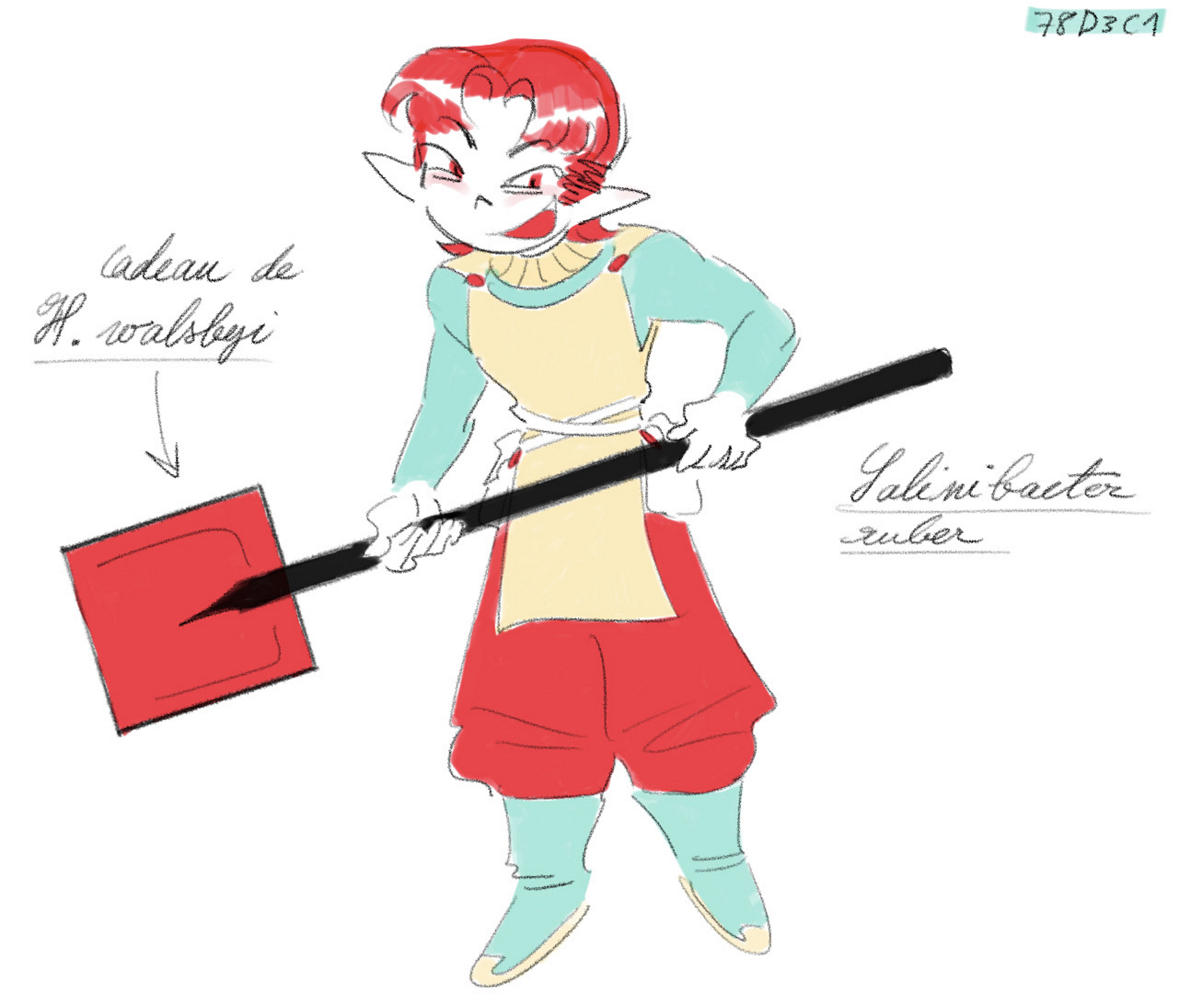Salinibacter ruber is a extremophilic, halophilic bacillus. He is one of few bacteria able to bear extremely high salt concentrations ; as such, he lives exclusively in salt lakes, which are otherwise primarily Haloarchaea-populated. Ruber owns a unique proton-pumping carotenoid, xanthorhodopsin, which gives him an intense red colour. High populations of Ruber are a determining factor behind the characteristic pink hues of many salt lakes 1. Unlike most Haloarchaea, Ruber is a very stubborn, uptight individual. He overimplicates himself in the lakes’ ecosystems, and makes a point to “watch over” them. He and Haloquadratum walsbyi are the two most common inhabitants of the salt lakes around the world 2 3.
Background
Ruber comes from the Rhodothermota, a phylum of red, halophilic, deep sea bacteria. When the Great Oxydation Event happened, the Rhodothermota were greatly upset, and Ruber had an argument with other members of the phylum. Eventually, he decided he would flee to the surface to live a life of his own, persuaded that green-based life wouldn’t be prevalent there.
When he did reach the surface, Ruber was immediately greeted by many Archaea, too busy grieving their own from the tragedy to recognise Ruber as a bacterium. Exasperated by the displays of despair, he eventually spotted a much taller, quieter, square-looking archaeon. This was Haloquadratum walsbyi, busy hypothesizing about the events. Walsbyi was the only one to reciprocally take notice of Ruber. They shared a common sentiment regarding the reactions of other Archaea, and this is how they came to stick together. Eventually, Walsbyi asked Ruber to help him surveilling the lakes for outside disturbances, which Ruber agreed to.
As the officiously appointed guardian of the lakes, Ruber soon became a familiar face to the halophilic archaea. Still, though everyone felt Ruber was a bit different, his nature as a bacterium remained unknown. Ruber actually felt it would be better to keep quiet about it; Bacteria can be halotolerant, but seldom as halophile as the Haloarchaea. He also feared repercussions of being associated with the Cyanobacteria, though very phylogenetically distant from them. So far, everyone was very nice to him: he was gifted useful genes 4, and he did not want people to feel betrayed.
But this was without counting on Walsbyi’s curious nature. For the sake of his taxonomic research, Walsbyi asked to examine Ruber a few times. Walsbyi grew more and more impressed, and intrigued, as he realised Ruber was extremely physiologically different from the other lake dwellers. When Ruber was confronted about this, he lost his temper, and put Walsbyi’s observation back into question, alluding to Walsbyi’s visual disability. Immediately, he realised the weight of his words, but it was too late. This altercation drew the both of them apart.
Ruber felt terribly guilty. Though still very popular, he realised life was a lot less fun to him without Walsbyi. To repair his fault, Ruber grew secretly obsessed with the idea of creating a tool to correct Walsbyi’s sight. Alas, the enterprise proved more difficult than Ruber anticipated. After one fateful encouter with a strange bacterium, Ruber finally managed to craft glasses for Walsbyi. After gifting him the glasses, the two of them got back along and cemented their place as the two major figured of the salt lakes all over the world.
Personnality
to be completed. basically he’s very headstrong
Relationships
Haloquadratum walsbyi
Walsbyi is Ruber’s primary friend. Ruber himself would never dare describe Walsbyi as a friend in public, yet that’s already understating how he feels about him. In public, he acts primarily as Walsbyi’s henchman. Ruber has been observered metabolically cooperating with Walsbyi in real life by degrading glycerol into dihydroxyacetone, a metabolite Walsbyi can then use as a source of carbon 5.
Dunalliela salina
D. salina is a species of carotenoid-rich green algae of the salt lakes. To Ruber and Walsbyi, D. salina are a major source of carbon 3. Ruber treats them as pets.
